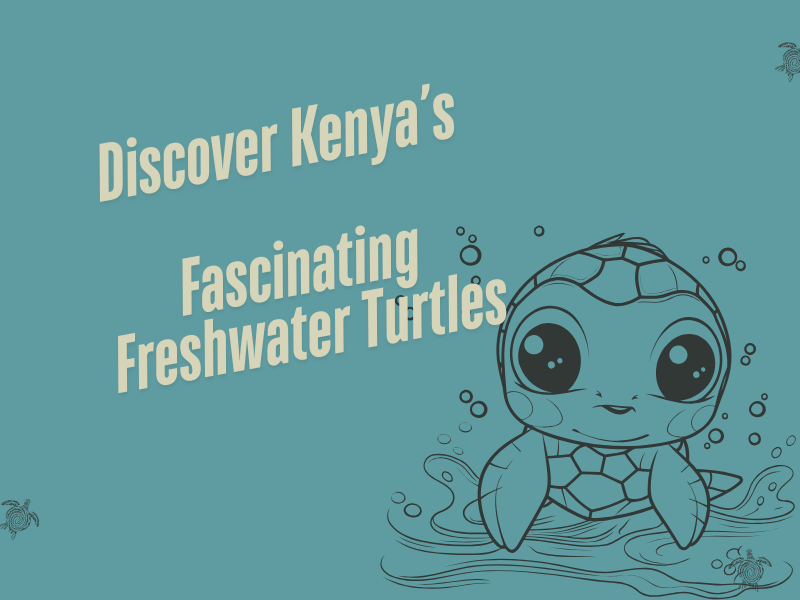Kenya is renowned for its breathtaking landscapes, diverse wildlife, and vibrant ecosystems. While the Big Five often steal the spotlight, the country’s freshwater habitats are home to some equally fascinating yet lesser-known residents: freshwater turtles. These ancient reptiles play a vital role in maintaining the health of Kenya’s rivers, lakes, and swamps.
Let’s dive into the world of Kenya’s freshwater turtles and learn more about these incredible creatures.
1. African Helmeted Turtle (Pelomedusa subrufa)
The African Helmeted Turtle is one of the most widespread freshwater turtles in Kenya. Found in rivers, lakes, and ponds, this adaptable species is easily recognizable by its flattened, helmet-like shell.
- Diet: Omnivorous, feeding on insects, small fish, and aquatic plants.
- Behaviour: Often seen basking on rocks or logs near the water’s edge.
- Fun Fact: These turtles can survive in temporary water bodies by burrowing into the mud during dry seasons.
2. Serrated Hinged Terrapin (Pelusios sinuatus)
The Serrated Hinged Terrapin is a unique species found in slow-moving rivers and lakes. Its name comes from the serrated edge on the back of its shell, which gives it a distinctive appearance.
- Diet: Primarily carnivorous, preying on aquatic invertebrates and small fish.
- Behaviour: Known for its ability to close its shell tightly to protect itself from predators.
- Fun Fact: This species is highly adaptable and can thrive in both natural and human-altered environments.
3. East African Black Mud Turtle (Pelusios subniger)
The East African Black Mud Turtle is a dark-coloured species that inhabits swamps, marshes, and slow-moving water bodies. Its sleek, dark shell and skin help it blend seamlessly into its muddy surroundings.
- Diet: Feeds on small aquatic prey, such as insects, crustaceans, and plants.
- Behaviour: Prefers to stay hidden in muddy or vegetated areas, making it less visible than other turtles.
- Fun Fact: This species is highly resilient and can survive in low-oxygen environments.
The Importance of Freshwater Turtles in Kenya’s Ecosystems
Freshwater turtles are essential to the health of aquatic ecosystems. They help control populations of insects and small fish, contribute to nutrient cycling, and serve as indicators of environmental health. However, these turtles face numerous threats, including:
- Habitat Loss: Due to urbanization, agriculture, and water pollution.
- Illegal Trade: Turtles are often captured for the pet trade or traditional medicine.
- Climate Change: Alters water levels and temperatures, affecting their habitats.
Conservation Efforts in Kenya
Kenya is taking steps to protect its freshwater turtles and their habitats. Key initiatives include:
- Protected Areas: Establishing and maintaining national parks and reserves that safeguard freshwater ecosystems.
- Community Involvement: Educating local communities about the importance of turtles and involving them in conservation efforts.
- Research and Monitoring: Studying turtle populations to better understand their needs and threats.
Organizations like the Kenya Wildlife Service (KWS) and local conservation groups are working tirelessly to ensure these species thrive for generations to come.
How You Can Help
- Support Conservation Organizations: Donate to or volunteer with groups working to protect freshwater habitats.
- Avoid Buying Wild-Caught Turtles: Choose captive-bred pets to reduce demand for wild turtles.
- Spread Awareness: Share information about Kenya’s freshwater turtles and their conservation needs.
Conclusion
Kenya’s freshwater turtles are a hidden gem of the country’s biodiversity. From the adaptable African Helmeted Turtle to the elusive East African Black Mud Turtle, these species are a testament to the beauty and resilience of nature. By learning about and supporting their conservation, we can ensure that these remarkable reptiles continue to thrive in Kenya’s waters.
Next time you’re near a river or lake in Kenya, take a moment to appreciate the turtles that call it home—they’re an essential part of the ecosystem and a symbol of Kenya’s rich natural heritage.

